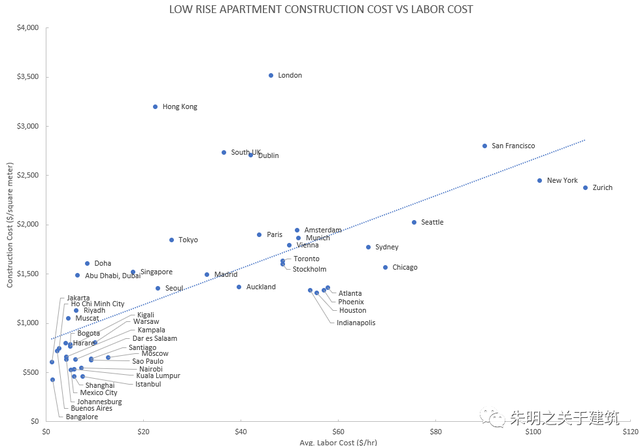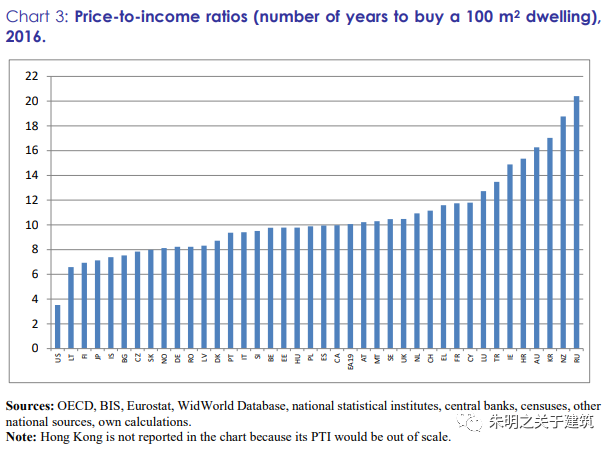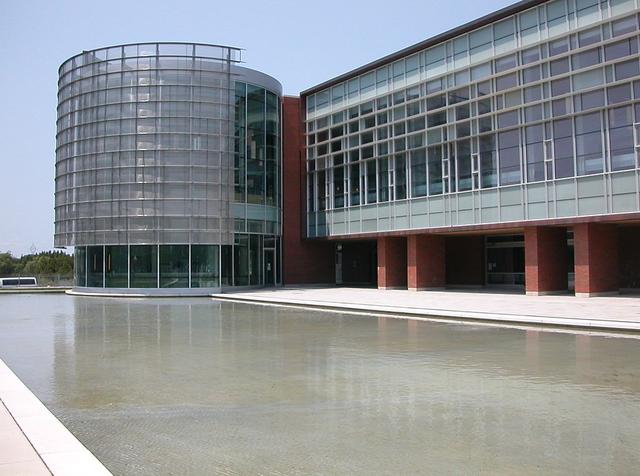行业思考:美国的建房成本高吗?
![]() 关注我们
关注我们
本文转译自Katerra的前员工Brian Potter在网上发表的一篇博文。
作者通过大数据分析对比,得出建造成本和劳动力价格及建筑材料价格的非相关性,并进一步得出美国的房价收入比处于较低水平……
Construction Costs Around the World: How Does the US Compare?
With a few exceptions, this newsletter has focused mostly on building construction in the US. It’s what I’m most familiar with, and what I’m most confident in my ability to accurately contextualize. And if construction were a globalized marketplace, we might expect conclusions drawn about the US market to generalize around the world. But of course construction is NOT a globalized marketplace, it’s a hyper-local one. So different regions will have different construction traditions, use different materials, make different capital/labor tradeoffs, and so on. Once in place, building technology tends to be difficult to dislodge, and extremely efficient methods might not diffuse through the market. So it’s useful to take a look at construction costs around the world, and see if there’s any obvious improvements the US could adopt.
除了少数例外,本通讯主要关注美国的建筑施工。这是我最熟悉的,也是我对自己的能力最自信的。如果建筑业是一个全球化的市场,我们可以期望得出的关于美国市场的结论可以推广到世界各地。当然,建筑业不是一个全球化的市场,而是一个超本地化的市场。所以不同的地区会有不同的建筑传统,使用不同的材料,做出不同的资本/劳动力权衡,等等。一旦到位,建筑技术往往很难被移除,而且极其有效的方法可能不会在市场上传播开来。所以,看看世界各地的建筑成本,看看美国是否可以采取任何明显的改进是很有用的。
For cost data, we can use the Turner and Townsend International Construction Market Survey. This is a survey of 64 different construction markets around the world, that asks respondents for cost information about different project types, materials, and labor. As always, construction costs have a high variance, so these values should be assumed to have some wide confidence intervals on them.
对于成本数据,我们可以使用特纳汤森国际建筑市场调查。这是一项针对全球64个不同建筑市场的调查,要求受访者提供不同项目类型、材料和劳动力的成本信息。与往常一样,建设成本有一个高的方差,所以这些值应该被假定有一些宽的置信区间。
Single Family Homes
To start, let’s look at single family home (SFH) construction, the largest category by number of buildings in the US. The graph below shows average construction cost per square meter vs average labor cost [1] for a “medium quality” home (click to embiggen):
首先,让我们来看看单户住宅(SFH)建设,这是美国建筑数量最多的一类。下图显示了“中等质量”住宅的平均每平方米建筑成本和平均人工成本[1]:

The first thing that jumps out here is how insensitive construction is to labor costs. Large increases in labor cost translate to very small increases in construction cost. Zurich has SFH construction costs just 3x those of Jakarta despite labor that’s 100x as expensive [2]!
首先要注意的是,建筑对劳动力成本是多么不敏感。劳动力成本的大幅增长转化为建筑成本的小幅增长。苏黎世的SFH建筑成本仅仅是雅加达的3倍,尽管劳动力是雅加达的100倍!
And if we look closer, even the modest relationship between labor and construction cost starts to break down. We can roughly see two clusters of countries on the graph. One cluster consists of Africa, South America, the Mideast, parts of Southeast Asia, and Eastern Europe. These are the countries in the bottom left of the graph, which have very low labor costs and (mostly!) low construction costs. The other cluster is spread across the rest of the graph, and consists of high labor cost ‘western’ countries.
如果我们仔细观察,即使劳动力和建筑成本之间的适度关系也开始瓦解。我们可以在图表上大致看到两组国家。其中一个集群包括非洲、南美、中东、部分东南亚和东欧。这些国家在图表的左下方,有非常低的劳动力成本和(大部分!)低的建设成本。另一个集群分布在图表的其余部分,由高劳动力成本的“西方”国家组成。
Within each of these groups, we see NO relationship between labor and construction cost:
在这些组中,我们没有看到劳动力和建筑成本之间的关系:

This is surprising to me. We’re constantly told how construction remains a craft-based, labor intensive business, and yet we see almost no influence of labor on construction costs between comparable countries. It only seems to matter with respect to whether you’re in a rich western country or not.
这让我很惊讶。我们经常被告知,建筑仍然是一个以工艺为基础的、劳动密集型的行业,但在可比国家之间,我们几乎看不到劳动力对建筑成本的影响。这似乎只与你是否在一个富裕的西方国家有关。
If we look at material costs, we see something similar:
如果我们看看材料成本,我们会看到类似的情况:

We don’t see much of a relationship between timber cost and SFH construction cost - we don’t even see country clusters here. And most of what’s there is driven by non-representative outliers like Hong Kong and Singapore. Plenty of places with identical timber costs vary in construction cost by a factor of 6 or more.
我们没有看到木材成本和SFH建筑成本之间有多大的关系——我们甚至没有看到这里的国家集群。其中大部分是由香港和新加坡等不具代表性的异常点推动的。许多有着相同木材成本的地方在建筑成本上相差6倍或更多。
So SFH construction doesn’t correlate much with labor costs or material costs. But there’s a large amount of variation to be explained, both between similar countries and within the same country. In the US, places like San Francisco and New York have some of the highest SFH construction costs in the world, whereas places like Atlanta, Phoenix, and Houston have some of the lowest among western countries (and compare favorably to the low labor cost countries) [3].
因此,SFH的建设与劳动力成本或材料成本没有太大关联。但有大量的差异需要解释,无论是在相似的国家之间还是在同一个国家内部。在美国,旧金山和纽约等地的SFH建设成本在世界上是最高的,而亚特兰大、凤凰城和休斯顿等地的SFH建设成本在西方国家中是最低的(比劳动力成本低的国家更好)。
There’s a few possible mechanisms at work. One is that there’s actually a large amount of variation in quality between homes built in different countries that the survey doesn’t capture. Maybe “medium quality” homes in the US are built shoddier or unsafely compared to European ones, or are very energy inefficient, or are missing lots of features.
有一些可能的机制在起作用。其中一个原因是,在不同国家建造的房屋之间存在着巨大的质量差异,而这项调查并没有捕捉到这些差异。也许美国的“中等质量”住宅与欧洲的相比,建造得更劣质或更不安全,或者能源效率非常低,或者缺少很多功能。
This probably explains some of the worldwide variation. But I don’t think it’s at work in low-cost US markets. As we’ve seen previously, homes built in the US are extremely long-lasting [4]. And despite an abundance of unsprinklered wood construction, the US also does relatively well on fire safety. And a comparison between US, Canadian, and European Energy codes found that US homes are roughly as energy efficient as European ones. As for features, this is purely anecdotal, but I’ve never seen anything in home renovation shows or YouTube home tours that would indicate that.
这可能解释了世界范围内的一些差异。但我不认为它在低成本的美国市场起作用。正如我们之前所看到的,在美国建造的房屋是极其持久的。尽管有大量未洒水的木质建筑,美国在防火安全方面也做得相对较好。对比美国、加拿大和欧洲的能源法规发现,美国家庭的能源效率大致与欧洲家庭相同。至于功能,这纯粹是轶事,但我从来没有在家居装修节目或YouTube家庭旅游中看到任何东西表明这一点。
Another possible mechanism is that labor costs are a reflection of worker efficiency. Perhaps their higher cost reflects their higher skill - in engineering, a senior engineer might cost 2x what a graduate engineer does, but they’ll get things done 5x as fast.
另一个可能的机制是,劳动力成本是工人效率的反映。也许他们更高的成本反映了他们更高的技术——在工程方面,一个高级工程师的成本可能是一个研究生工程师的两倍,但他们完成事情的速度是研究生工程师的5倍。
Or if cost is independent of skill (through something like cost disease), higher labor causes management to use that labor more effectively, through better training, better tools, etc. If your labor costs go up, you find ways to use that labor more efficiently, so your overall costs don’t change much. I think these are both probably at least part of the explanation, but it raises the question why extremely expensive markets aren’t able to capitalize on this.
或者,如果成本独立于技能(通过诸如成本疾病之类的东西),更高的劳动力会导致管理层通过更好的培训、更好的工具等更有效地使用劳动力。如果你的劳动力成本上升,你会找到更有效地使用劳动力的方法,所以你的总体成本不会有太大变化。我认为这两个可能都是部分解释,但它提出了一个问题为什么极其昂贵的市场不能利用这一点。
A third mechanism is differences in administrative costs. These can vary wildly by jurisdiction - Both New York and San Francisco have famously obtuse construction approval processes which require mountains of time and expense to navigate, and make them cost outliers in the US. This is possibly at work in Hong Kong as well. Under this model, construction cost would consist of a constant “cost to actually build the building” factor, and a variable administrative burden. I think this is part of the answer as well.
第三个机制是行政成本的差异。不同地区的情况差别很大——纽约和旧金山的建筑审批程序都是出了名的迟钝,需要大量的时间和费用才能通过,这在美国是成本异常值。这可能也在香港发生。在这个模型下,建筑成本将包括一个不变的“实际建造建筑的成本”因素和一个可变的行政负担。我认为这也是答案的一部分。
And of course, it’s always possible that the numbers are just wrong. They could be biased in one direction or the other, or reflect optimistic project cost predictions that won’t pan out, or fail to capture the use of undocumented labor in their labor costs. Survey data is not as good a source of information as measuring actual project costs would be. Or perhaps there are selection effects at work, and we’re comparing the least expensive US cities to the most expensive cities in other countries.
当然,也有可能这些数字是错的。它们可能会偏向某个方向,或者反映出不会成功的乐观项目成本预测,或者未能在其劳动力成本中捕捉到未登记劳动力的使用。调查数据不像测量实际项目成本那样是一种很好的信息来源。或者可能是选择效应在起作用,我们将美国最便宜的城市与其他国家最昂贵的城市进行比较。
I think it’s highly likely the numbers are incorrect to some degree. But they do roughly match up with my own experience, and seem mostly in accordance with other sources.
我认为很有可能这些数字在某种程度上是错误的。但它们确实与我自己的经历大致相符,而且似乎与其他资料基本一致。
Regardless of the mechanism at work, there’s not much evidence that the US is failing to adopt efficient SFH construction methods that are used elsewhere in the world.
不管起作用的机制是什么,没有多少证据表明美国未能采用世界其他地方使用的高效的SFH施工方法。
Multifamily Construction
多户家庭的建设
If we look instead at low-rise multifamily construction, the overall picture doesn’t change all that much:
如果我们看看低层多户型建筑,整体情况不会有太大改变:

We see the same country clusters, and mostly the same relative location of the different construction markets. One interesting thing is that while most markets have a higher cost of construction for low-rise apartments than they do for single family homes, the US markets all have a LOWER cost.
我们看到相同的国家集群,以及不同建筑市场的相对位置大致相同。有趣的是,尽管大多数市场的低层公寓建设成本高于单户住宅,但美国市场的成本都较低。
This, I believe, is almost entirely driven by construction type. For single family homes, it’s common to build them out of wood all over the world. But for larger buildings such as multifamily apartments, concrete or steel is largely used instead. Except in the US - here, we still build large multifamily apartments with wood, more or less the same way we build our single family homes. This lets us build multifamily apartments substantially cheaper than other western countries.
我认为,这几乎完全是由建筑类型驱动的。对于独栋住宅,在世界各地用木头建造是很常见的。但对于多户公寓等较大的建筑,则主要使用混凝土或钢材。除了在美国,在这里,我们仍然用木头建造大型多户公寓,和我们建造独户住宅的方式差不多。这让我们可以建造比其他西方国家便宜很多的多户型公寓。
Once again, we see little relationship between material cost and construction cost:

Multifamily doesn’t change the picture much - if anything, it makes the US construction look even MORE efficient.
多户型并不能改变现状——如果有什么不同的话,那就是它让美国的建筑看起来更有效率。
Other Project Types
其他项目类型
But things start to change a bit once we start looking at larger, more involved project types:
但当我们开始关注更大、更复杂的项目类型时,情况就开始有所改变:

The above graph shows the costs for several different project types, in several different cities both in the US (colored lines) and around the world (grey lines). On the left, we see that for low rise office projects, the trend is similar to what we saw with apartments or homes - the cheapest US markets are as inexpensive as other western markets. But as we move to the right, costs in even inexpensive US markets like Phoenix or Atlanta start to exceed those of European and Asian cities. For airports, US construction costs in ANY market are higher than anywhere else in the world (outside of Switzerland and Hong Kong).
上面的图表显示了几个不同项目类型的成本,在美国(色线)和世界各地(灰线)的几个不同城市。在左边,我们看到低层办公项目的趋势与我们看到的公寓或住宅类似——最便宜的美国市场与其他西方市场一样便宜。但随着我们向右移动,即使是凤凰城或亚特兰大这样的廉价美国市场的成本也开始超过欧洲和亚洲城市。就机场而言,美国在任何市场的建设成本都高于世界其他任何地方(除瑞士和香港以外)。
The projects are arranged partially in order of project size and complexity, but this isn’t the whole story. The US still looks good on residential high rise construction, which are large and complex projects, and even a low-rise apartment complex can be huge in terms of building area.
这些项目是按照项目规模和复杂性的顺序进行部分安排的,但这并不是全部。美国的高层住宅建设看起来仍然不错,这是大型和复杂的项目,甚至一个低层公寓综合体的建筑面积也可能很大。
A better interpretation is that they’re arranged in order of increasing administrative and government overhead. Universities, hospitals, and airports all have extremely involved project management processes, and huge amounts of government requirements and oversight. As administrative costs rise - the more involved the government is in projects - the worse the US does compared to other countries.
This tracks with US performance on infrastructure projects, where US performance is similarly government-involved and similarly poor.
更好的解释是,它们是按照增加行政和政府开支的顺序排列的。大学、医院和机场都有非常复杂的项目管理流程,以及大量的政府要求和监督。与其他国家相比,随着行政成本的上升——项目参与程度越高——美国的表现就越差。
这与美国在基础设施项目上的表现相符,美国在这些项目上的表现同样由政府参与,也同样糟糕。
This seems to confirm at least in part the administrative overhead theory, and suggests a model: Other western countries have a great deal of government involvement in all aspects of building. This makes much of their construction more expensive on average. But for projects which require a great deal of government involvement (such as hospitals or airports), this changes from a drawback to a benefit, as the higher quality of their civil service leads to lower project costs.
这似乎至少在一定程度上证实了行政管理费用理论,并提出了一个模型:其他西方国家在建设的各个方面都有大量的政府参与。平均而言,这使得他们的建筑成本更高。但对于需要大量政府参与的项目(如医院或机场),这就从不利变为有利,因为较高的公务员服务质量可以降低项目成本。
Construction Costs and Property Values
建筑成本和财产价值
It’s also useful to see how these construction costs translate to real estate prices. For this data, we can turn to this study by Bricongne, Turrini and Pontuch. They used government and census data to find the total residential floor area, and total residential building value, for a variety of different countries (supplementing it with real estate data where needed). The result is the average price per square meter of residential real estate:
看看这些建筑成本如何转化为房地产价格也很有用。对于这些数据,我们可以参考Bricongne, Turrini和Pontuch的研究。他们利用政府和人口普查数据,找出不同国家的总住宅建筑面积和总住宅建筑价值(在需要时补充房地产数据)。其结果是住宅地产每平方米的平均价格:

This mostly matches our previous conclusion - the US compares very favorably to other western, high income countries. And when you combined it with income data, you see what an outlier the US is:
这与我们之前的结论基本一致——与其他西方高收入国家相比,美国的情况非常好。当你把它和收入数据结合起来时,你会发现美国是一个异常值:

The US (the country on the far, far left) has a housing / income ratio nearly half that of the next best country, and almost a third of the European average [5]. On a unit-area metric, the US builds some of the most affordable homes in the world.
美国(最左边的国家)的住房/收入比接近第二好的国家的一半,几乎是欧洲平均水平[5]的三分之一。按单位面积衡量,美国建造了世界上最经济的一些住房。
Putting it All Together
汇总
So, to summarize:
总结一下:
We see almost no relationship between labor OR material costs, and construction costs for residential construction, outside of whether you’re in a western country or not.
我们几乎看不到劳动力或材料成本,和住宅建设成本之间的关系,除了你是否在西方国家。
The US does particularly well at building homes, apartments, and other projects that have low administrative overhead or government involvement.
美国在建造房屋、公寓和其他低政府参与的项目方面做得特别好。
The US does particularly poorly at projects with a high degree of administrative burden, government oversight, or where the government is a major stakeholder. European countries do far better by comparison.
美国在有高度行政负担、政府监督或政府是主要利益相关者的项目上做得特别差。相比之下,欧洲国家的表现要好得多。
There’s little evidence that US homes are built to worse standards than in comparable countries.
几乎没有证据表明,美国住宅的建造标准低于类似国家。
For residential construction, there’s little evidence that other countries have substantially more efficient construction methods that the US should adopt.
在住宅建设方面,几乎没有证据表明其他国家有比美国更有效的建筑方法。
In the US, low construction costs translate to low property prices, making the US an outlier in housing affordability on a unit-area metric.
在美国,较低的建筑成本转化为较低的房地产价格,使美国在单位面积住房负担能力方面成为一个异常值。
[1] Labor cost is the cost to the employer, and includes things like transportation, taxes, etc.
人力成本是雇主的成本,包括交通、税收等。
[2] GDP per capita is 82,000 USD in Switzerland, vs 3893 in Indonesia, a 20x difference.
瑞士的人均GDP是8.2万美元,而印度尼西亚是3893美元,相差20倍。
[3] There’s a modest, but not perfect, correlation between low construction costs and metro area population growth in the US.
在美国,低建筑成本和都市地区人口增长之间有一种适度的、但并非完美的关联。
[4] Far longer than they will somewhere like Japan, which has a housing replacement rate 2x most other comparable countries.
远比日本等国家要长,日本的住房置换率是其他同类国家的两倍。
[5] This is damped somewhat by the fact (and also helps to explain the fact) that the average US home size is much larger than the average European home size.
美国平均住宅面积远大于欧洲平均住宅面积,这一事实(也有助于解释这一事实)削弱了这一趋势。
12/31 Update - PPP Adjustment
The Turner and Townsend Cost data uses exchange-rate adjusted costs to USD. However, it’s probably more accurate to compare using purchasing power parity (PPP) rather than exchange rate. Factoring by OECD and Worldbank PPP data yields the following for single family and low-rise multi family construction:
特纳和汤森成本数据使用汇率调整成本换算成美元。然而,使用购买力平价(PPP)可能比使用汇率更准确。根据经合组织(OECD)和世界银行(Worldbank)的PPP数据,对单户住宅和低层多户住宅建筑进行保理后得出如下结论:


The overall picture doesn’t change much - we still see a weak relationship between labor and construction cost, and we still see the US performing better than most other western countries. The main difference is that the cluster of low-cost, low wage countries is more spread out, and less distinct.
总体情况没有太大变化——我们仍然看到劳动力和建筑成本之间的关系较弱,我们仍然看到美国比大多数其他西方国家表现更好。主要的区别是,低成本、低工资国家的集群更分散,更不明显。
Links
Fruit Walls - An urban farming technique from the 1600s. Fruit walls were fruit trees or vines grown next to a heavy wall with high thermal mass that would allow fruit to grow in climates that otherwise wouldn’t support it.
水果墙-一种来自17世纪的城市农业技术。水果墙是指果树或葡萄藤生长在厚墙的旁边,高热量的墙壁可以让水果在不支持它的气候下生长。
Tall, slender buildings often need some kind of damper to prevent the top from swaying back and forth. Often this is a tuned mass damper, a large mass on springs or oil. Rainer Square in Seattle uses two sloshing dampers, large tanks filled with water.
又高又细的建筑通常需要某种阻尼器来防止顶部前后摇摆。这通常是一个调谐质量阻尼器,一个大质量的弹簧或油。西雅图的Rainer广场使用了两个晃动阻尼器,这是一个装满水的大水箱。
Site Selection Magazine is a publication about corporate real estate and building industrial facilities. Like most publications on hyper-specific subject matters, it’s a lot more interesting than you might expect.
《选址》杂志是关于企业房地产和工业设施建设的刊物。像大多数关于超特定主题的出版物一样,它比你想象的要有趣得多。























评论